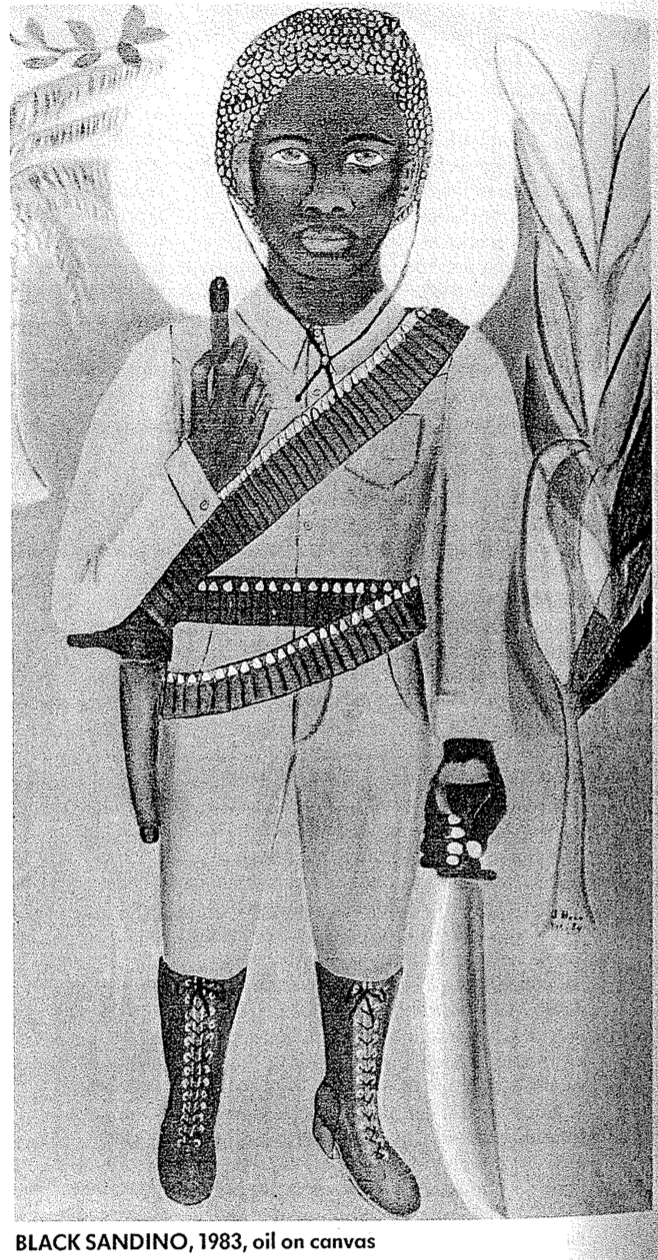In celebration of Black History Month, the Quixote Center is launching a weekly series to highlight the history, leaders, and cultures of Afro-descendant communities in Central America, Mexico, and Haiti.
This week, we are celebrating the life of the Nicaraguan painter and poet, June Beer. In 1935, June Beer was born in Bluefields, Nicaragua. A self-taught artist and the first female poet from Nicaragua’s Atlantic coast, Beer wrote in Nicaraguan Creole English and Spanish. She explored themes of Black identity, feminist empowerment, and her local environment.

Black Sandino by June Beer[/caption]
Beer dedicated her work to representing through art and writing her Afro-Nicaraguan heritage. Unbeknownst to many, Nicaragua is home to the largest population of Afro-Latinos in Central America, representing 9% of the total population. Most live on the Atlantic coast, which was occupied by the British for several centuries and is thus culturally distinct from the rest of the country.
Afro-Nicaraguans are extremely diverse in origin, mostly comprised of several main groups: Afro-indigenous groups, namely the Miskitos who are the descendants of Spanish enslaved peoples and indigenous Nicaraguans; Creoles, the descendants of enslaved peoples from Anglo-Caribbean countries such as Jamaica; and the Garifuna, who are descendants of indigenous Caribbeans and escaped enslaved peoples.
Throughout her life, Beer was outspoken against repression in all forms. She openly criticized the Somoza dictatorship, leading to her being imprisoned by the La Guardia twice, in 1970 and 1971. Beer stated that Bluefields during Somoza “was a region that was so forgotten and ignored. No one was encouraged to dream, to think of the future, or of art, but only to make a little money for sustenance.”
Beer returned to Managua two years after, where she struggled to carve out a space for herself. Popular artists at the time criticized her work for not being more like the detailed landscapes by the Primitivist artists from the Solentiname Islands.
However, it was her unique expression of Bluefields and Afro-Nicaraguan identity that led to her widespread recognition. Her art has been displayed internationally, across Latin America, the Caribbean, Europe, Asia, and the United States. After her death in 1986, the government proclaimed four of her paintings—Fruit Seller, In Memory of Efie Irene, They Dance and Woman Working—part of the national patrimony, making it illegal to remove them from the country.
Click HERE to see some of Beer’s most well-known artwork. To read one of her poems, continue below:
LOVE POEM
Oscar, yuh surprise me,
Assin far a love poem.
Ah sing a song a love fa me contry
Small contry, big lite
Hope fad a po’, big headache fa de rich.
Mo’ po’ dan rich in de worl
Mo’ people love fa meh contry.
Fa meh contry name Nicaragua
Fa meh people ah love dem all
Black, Miskito, Sumu, Rama, Mestizo.
So yuh see fa me,
love poem complete ‘cause ah love you too.
Dat no mek me erase de moon
an de star fran de firmament.
Only somehow wen ah rememba
how yuh bussing yo ass
to defend dis sunrise, an keep back
de nigth fran fallin,
ah know dat tomara we will have time
fa walk unda de moon an stars.
Dignify an free, sovereign
children a Sandino.
(from Mujeres de sol y luna: Poetas nicaragüenses 1970-2007,
Edited by Helena Ramos, Managua, ANE Noruega CNE)


Comments
Thomas H Cartwright (not verified)
Thanks for posting this...I learned a lot.
Patricia (not verified)
I need a copy of this book. Thanks